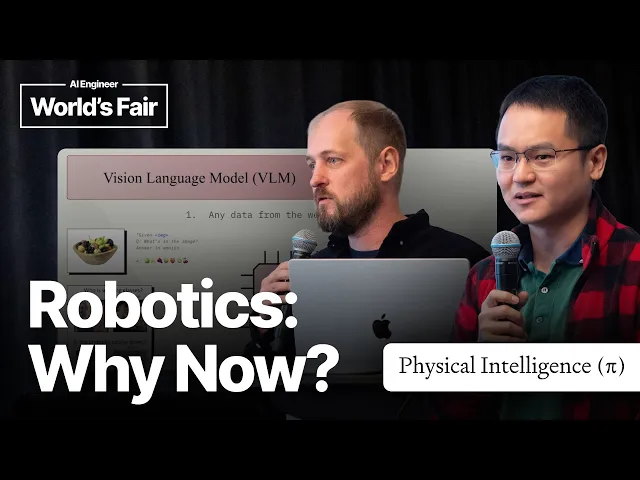Robotics: why now? – Quan Vuong and Jost Tobias Springberg, Physical Intelligence

Robotics revolution arrives for business opportunities
The robotics industry stands at a unique inflection point, poised for explosive growth after decades of incremental development. In a fascinating discussion between Quan Vuong and Jost Tobias Springberg of Physical Intelligence, they examine why robotics is finally ready for mainstream business adoption. Their conversation reveals the perfect convergence of technological advances, market conditions, and economic incentives that make this moment special for robotics implementation.
Key insights from their discussion:
-
The robotics industry has reached a critical inflection point where technological capabilities, market demand, and economic incentives have aligned to enable widespread adoption across diverse business sectors.
-
Previous barriers to robotics adoption—including high costs, limited adaptability, and programming complexity—have been systematically dismantled through innovations in hardware, software, and AI integration.
-
The evolution of AI has fundamentally transformed robotics from rigid, pre-programmed systems to adaptive tools capable of learning new tasks and operating in unstructured environments—dramatically expanding their business applications.
Why this inflection point matters now
The most compelling insight from the discussion centers on the fundamental shift in what robotics can accomplish. Unlike earlier generations of industrial robots confined to fixed, repetitive tasks behind safety cages, today's robots can work alongside humans in unpredictable environments. This capability transformation represents more than incremental progress—it's a paradigm shift that dramatically expands where and how businesses can deploy robotic solutions.
This matters immensely because it coincides with unprecedented labor shortages across industries. Manufacturing, warehousing, healthcare, and service sectors face persistent workforce gaps that traditional automation couldn't address. Modern robotics uniquely solves this problem by handling variable tasks in environments designed for humans, not machines. For businesses struggling with staffing constraints, robotics now offers a viable solution without requiring expensive facility redesigns or workflow overhauls.
Looking beyond the obvious applications
While the discussion focused primarily on industrial applications, the robotics revolution extends far beyond manufacturing. Consider healthcare, where nursing shortages have reached crisis levels. Companies like Diligent Robotics have developed Moxi, an autonomous robot that handles non-patient-facing logistical tasks in hospitals—medication delivery, supply restocking, and equipment transport. By relieving nurses of these duties, each robot effectively returns 30-40
Recent Videos
How To Earn MONEY With Images (No Bullsh*t)
Smart earnings from your image collection In today's digital economy, passive income streams have become increasingly accessible to creators with various skill sets. A recent YouTube video cuts through the hype to explore legitimate ways photographers, designers, and even casual smartphone users can monetize their image collections. The strategies outlined don't rely on unrealistic promises or complicated schemes—instead, they focus on established marketplaces with proven revenue potential for image creators. Key Points Stock photography platforms like Shutterstock, Adobe Stock, and Getty Images remain viable income sources when you understand their specific requirements and optimize your submissions accordingly. Specialized marketplaces focusing...
Oct 3, 2025New SHAPE SHIFTING AI Robot Is Freaking People Out
Liquid robots will change everything In the quiet labs of Carnegie Mellon University, scientists have created something that feels plucked from science fiction—a magnetic slime robot that can transform between liquid and solid states, slipping through tight spaces before reassembling on the other side. This technology, showcased in a recent YouTube video, represents a significant leap beyond traditional robotics into a realm where machines mimic not just animal movements, but their fundamental physical properties. While the internet might be buzzing with dystopian concerns about "shape-shifting terminators," the reality offers far more promising applications that could revolutionize medicine, rescue operations, and...
Oct 3, 2025How To Do Homeless AI Tiktok Trend (Tiktok Homeless AI Tutorial)
AI homeless trend raises ethical concerns In an era where social media trends evolve faster than we can comprehend them, TikTok's "homeless AI" trend has sparked both creative engagement and serious ethical questions. The trend, which involves using AI to transform ordinary photos into images depicting homelessness, has rapidly gained traction across the platform, with creators eagerly jumping on board to showcase their digital transformations. While the technical process is relatively straightforward, the implications of digitally "becoming homeless" for entertainment deserve careful consideration. The video tutorial provides a step-by-step guide on creating these AI-generated images, explaining how users can transform...
